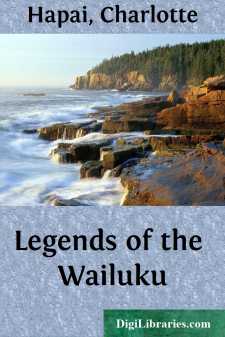Categories
- Antiques & Collectibles 13
- Architecture 36
- Art 48
- Bibles 22
- Biography & Autobiography 813
- Body, Mind & Spirit 142
- Business & Economics 28
- Children's Books 17
- Children's Fiction 14
- Computers 4
- Cooking 94
- Crafts & Hobbies 4
- Drama 346
- Education 46
- Family & Relationships 57
- Fiction 11829
- Games 19
- Gardening 17
- Health & Fitness 34
- History 1377
- House & Home 1
- Humor 147
- Juvenile Fiction 1873
- Juvenile Nonfiction 202
- Language Arts & Disciplines 88
- Law 16
- Literary Collections 686
- Literary Criticism 179
- Mathematics 13
- Medical 41
- Music 40
- Nature 179
- Non-Classifiable 1768
- Performing Arts 7
- Periodicals 1453
- Philosophy 64
- Photography 2
- Poetry 896
- Political Science 203
- Psychology 42
- Reference 154
- Religion 513
- Science 126
- Self-Help 84
- Social Science 81
- Sports & Recreation 34
- Study Aids 3
- Technology & Engineering 59
- Transportation 23
- Travel 463
- True Crime 29
Legends of the Wailuku
by: Charlotte Hapai
Categories:
Description:
Excerpt
THE WAILUKU.
Fed from the great watershed of Hawaii far up the densely wooded flanks of Mauna Loa and Mauna Kea—often snow-capped in winter—the Wailuku River roars through the very center of Hilo, principal town of the Island of Hawaii.
There are many vague stories as to why the Wailuku River was so named. In the Hawaiian tongue Wailuku means literally "destroying water."
In olden times before there were bridges and other safeguards the river wrought considerable damage to property and during the rainy season it took its toll of human lives. Legends connected with the Wailuku tend to confirm the belief that it was named for its violent habits.
Long ago, so one legend goes, the much dreaded Kuna (dragon) blocked the gorge below Rainbow Falls with intent to back the waters up and drown the goddess Hina, who dwelt in the great cave for which the falls form a curtain. How her son, the demi-god Maui, came to the rescue, saved his mother, and finally hunted Kuna from his lair up the river and slew him, is told in the legend, "The Last of Kuna."
When Paoa, a very powerful god from Tahiti, came to visit Hawaii he built a grass hut and made his home on the long, low rock—now known as Maui's canoe—in the Wailuku near its mouth.
Local gods viewed this selection of a homesite as foolhardy, but Paoa was unaware of the sudden and rapid rise the river made when heavy rains and cloud-bursts loosed their torrents high upon the slopes of Mauna Kea. Hina, goddess of the river, warned the visitor of his danger and told him how the angry waters would sweep everything before them. In the legend, "The Coming of Paoa," you will find his answer.
In those days there must have been much more water in the river than there is today, for a certain amount is now diverted above Rainbow Falls for water power.
In spite of the decreased volume the river is still very violent and treacherous. At high water big boulders are clumsily rolled down stream and when the river is unusually high even trees are torn from the banks and carried out to sea.
So the Wailuku still lives up to its name, Destroying Water.
HOW HILO WAS NAMED.
King Kamehameha the Great was a very famous warrior. His chief ambition, which he lived to realize, was to become sole ruler of all the Hawaiian Islands. Naturally he had numerous enemies, and he never remained long in one place for fear some of them might learn of his whereabouts and attack him.
One time, when he was encamped near the mouth of the Wailuku, he planned a quiet visit to what is now known as Reed's Island, where lived a particular friend of his. As this friend was a powerful chief, Kamehameha felt safe in going to him without his usual warrior bodyguard.
Before leaving camp he called his servants to him and told them to stand watch over his canoe, that it might not be stolen or carried away by the tide. This they promised faithfully to do.
As time passed and the king did not return or send word to his servants they grew uneasy about him. Perhaps he might have been ambushed, they reasoned; or more likely fallen into one of the caverns formed by ancient lava flows and which are often treacherously concealed by a thin, brittle crust that a man of Kamehameha's bulk might easily break through....


